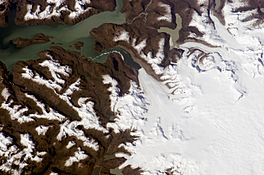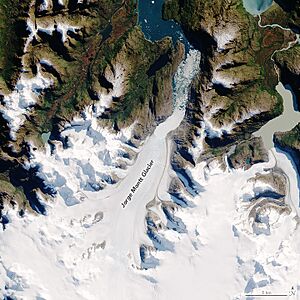Jorge Montt Glacier facts for kids
Quick facts for kids Jorge Montt Glacier |
|
|---|---|
 |
|
| Type | Tidewater glacier |
| Location | Chile |
| Coordinates | 48°22′S 73°30′W / 48.367°S 73.500°W |
| Area | 464 km2 (179 sq mi) |
| Terminus | Sealevel |
| Status | Retreating |
The Jorge Montt Glacier is a huge river of ice found in Chile, a country in South America. It's located in the Aisén Region, south of a small town called Caleta Tortel. This glacier is special because it's a tidewater glacier. This means it flows right into the ocean!
It sits at the northern end of the Southern Patagonian Ice Field, which is a massive area of ice. The glacier is part of Bernardo O'Higgins National Park. Near where the glacier meets the water, the Pascua River also flows into the sea.
Contents
How the Glacier Changes
The Jorge Montt Glacier covers a large area, about 510 square kilometers (197 square miles). This glacier is getting thinner, especially in its lower parts where the air is warmer.
Between 1975 and 2000, the glacier lost about 3.3 meters (11 feet) of thickness each year on average. In its lowest parts, it lost as much as 18 meters (59 feet) per year! Because it was thinning so fast, the front of the glacier, where ice breaks off, moved back a lot. It retreated about 8.5 kilometers (5.3 miles) in those 25 years. As it retreats, large pieces of ice break off, forming icebergs that float into the Baker Channel.
Studies on Glacier Retreat
In 2000, NASA (the U.S. space agency) studied the glaciers in this region. They compared old maps from the 1970s and 1990s with new data from their Shuttle Radar Topography Mission in 2000. Scientists found that the speed at which glaciers in Patagonia were thinning more than doubled between 1995 and 2000, compared to the period from 1975 to 2000.
A new study came out in December 2011. This research was led by glaciologist Andrés Rivera. He looked closely at how the glacier changed between February 2010 and January 2011. By using 1,445 photos taken during that year, scientists discovered something amazing. The glacier was shrinking by about 82 feet (25 meters) every single day! In just one year, it moved back more than half a mile (about 0.8 kilometers).
Rivera's study showed that the main reason for this fast retreat was the unique shape of the fjord (a long, narrow sea inlet) where the glacier ends. A warming climate also played a part in its retreat.
Ancient Trees Found Under the Ice
In 2010, scientists made an interesting discovery. They found parts of old Nothofagus trees (also known as southern beech trees) that had been buried under the ice. When they tested these tree parts, they found they were between 250 and 460 years old.
According to Rivera, these tree rings showed that the area used to be a very old forest. It was mostly made up of Nothofagus betuloides trees, which are also called Magellanic southern beech. These trees were about 150 years old on average. The forest had been growing for almost 300 years. The age of the trees suggests that this mature forest was destroyed when the Jorge Montt Glacier advanced during a period called the Little Ice Age.
See also
 In Spanish: Glaciar Jorge Montt para niños
In Spanish: Glaciar Jorge Montt para niños
- List of glaciers
- Retreat of glaciers since 1850


